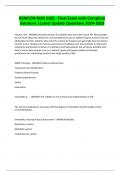BSMCON NUR 2102 - Final Exam with Complete
Solutions |Latest Update Questions 2024-2025
hospice care - ANSWER provides services for patients who are at the end of life. Many people
do not know about this option for care and depend on you to explain hospice services and care
philosophy to them. Patients who meet the criteria for hospice care generally have less than 6
months to live. Hospice care focuses exclusively on palliative care interventions to relieve the
symptoms and burdens of illness or treatment and help patients live as fully as possible until
death. Nurses base hospice care on a patient's goals and support patient and family
preferences for maintaining comfort and a high quality of life.
QSEN Principles - ANSWER Patient-Centered Care
Teamwork and Collaboration
Evidence-Based Practice
Quality Improvement
Safety
Informatics
Immobility is... - ANSWER The inability to move freely and independently at will.
The risk of complications increases with the degree of immobility and the length of time
of immobilization.
Immobility: Nursing Process Assessment - ANSWER Mobility
Respiratory system
Metabolic system
Cardiovascular system
,Skin integrity
Elimination system
Psychosocial condition
Development
Older adult considerations
Respiratory System Immobility - ANSWER Perform a respiratory assessment at least every
2 hours for acutely ill patients with restricted activity.
Psychosocial Effects of Immobility - ANSWER -Emotional and intellectual responses
-Depression, social isolation, sleep-wake disturbances, and impaired coping
-Sensory alterations
-Sociocultural responses
-Immobilization reduces a patient's independence and creates a sense of loss. As a
result, emotional, intellectual, sensory, and sociocultural responses occur.
-Because immobilization removes the patient from a daily routine, he or she has more time
to worry about disability.
-Disruption of normal sleeping patterns owing to nursing interventions causes further
behavioral changes and affects coping patterns.
Psychosocial Condition - ANSWER Changes in psychosocial status usually occur slowly. Observe
for changes in emotional status (e.g., depression) and behavioral changes. Evaluate patients'
readiness to improve their level of independence. Be prepared to adapt teaching and
motivational strategies to meet their expectations and needs
Older Adult Considerations - ANSWER Immobility has a significant effect on the older adult's
level of health, independence, and functional status. As the person grows older, activity
tolerance changes. The more inactive a patient is, the more pronounced are the changes
Immobility: Nursing Process Planning - ANSWER Goals and outcomes
,Patient-centered goals and outcomes aimed at preventing or reducing immobility hazards
and achieve highest level of mobility
Setting priorities
The effect that problems have on patients' mental and physical health determines the urgency
of any problem
Collaborative care
Patient, family, specialists, community resources
Immobility: Nursing Process Implementation - ANSWER Health promotion
Prevention of work-related injuries
Fall prevention measures
Exercise
Older adult considerations
Preventing disuse syndrome
Immobility: Nursing Process Evaluation - ANSWER Patient care
**If expected outcomes are not achieved, revise the plan of care.
**Base the success in meeting each outcome on the use of evaluative measures such as
ROM status, exercise tolerance, skin integrity, and fluid intake.
Patient expectations
**Patients want control over their mobility.
**Ask the patient if expectations are being met.
stressors affecting self-concept - ANSWER Identity stressors
Especially during adolescence
, Body image stressors
Affect appearance, structure, or function of body
Role performance stressors
Relationship or situational transitions and illness
Self-esteem stressors
Vary by developmental stage
Sexuality stressors
Occur across the lifespan
Identity - ANSWER involves the internal senses of individuality, wholeness, and consistency of
self. It includes the sense of a person over time and in different situations. Identity is formed in
childhood as children learn culturally acceptable values, behaviors, and roles through
identification and modeling. Part of this identity includes gender awareness and sexual identity.
Body Image - ANSWER involves attitudes related to physical appearance, structure or function.
It relates to the perception of the body, including physical appearance, femininity and
masculinity, youthfulness, health, and strength. Body image is the mental picture of one's
body and is not necessarily consistent with a person's actual body structure or physical
appearance. Feelings about body image include those also related to sexuality, femininity,
masculinity, youthfulness, health, and strength. Racial and ethnic background can influence
one's ideas regarding body image. Values such as ideal body weight and shape, as well as ideas
about body piercing and tattoos, youth, beauty, and Western culture's ideas regarding aging,
impact self-concept and self-esteem.
Role performance - ANSWER how individuals carry out their significant roles. It includes roles
such as parent, supervisor, or close friend. Societal roles oftentimes impact how we perceive
role performance. Having difficulty living up to perceived societal or cultural standards can
affect self-concept and self-esteem.




